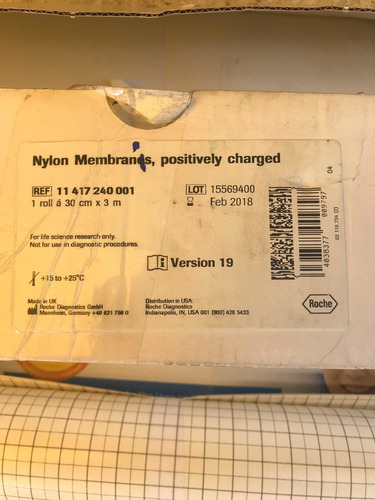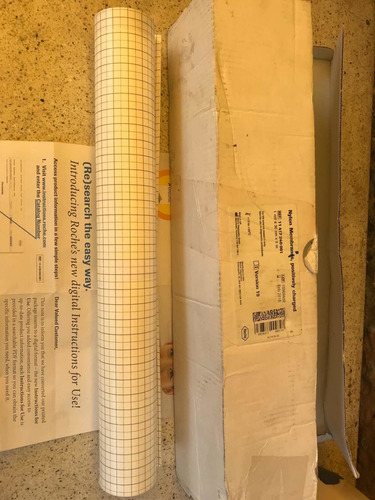


Membrana Filtro De Nylon (45 Um) Rollo 30 Cm X 3m
Características del producto
Características principales
Marca | Roche |
|---|---|
Modelo | 11 417 240 001 |
Descripción
Nylon Membranes, positively charged
Cat. No. 11 417 240 001 1
Roll à 0.3 × 3 m
1. Product overview
Product description Nylon membranes, are microporous, positively charged, ultra-pure nylon, bound to a polyester support.They are cationic and maintain their positive charge over a wide pH range. These membranes therefore have a high binding capacity for DNA and RNA under standard Southern-, Northern- and dot-blot conditions (1, 2), as well as in alkaline transfer procedures (3, 4).
Pore size0.45 m
Surface propertiesHydrophilic, with positive Zeta-surface potential between pH 2.0 and pH 12.0.
Nylon Membranes, positively charged
Cat. No. 11 417 240 001 1
Roll à 0.3 × 3 m
1. Product overview
Product description Nylon membranes, are microporous, positively charged, ultra-pure nylon, bound to a polyester support.They are cationic and maintain their positive charge over a wide pH range. These membranes therefore have a high binding capacity for DNA and RNA under standard Southern-, Northern- and dot-blot conditions (1, 2), as well as in alkaline transfer procedures (3, 4).
Pore size0.45 m
Surface propertiesHydrophilic, with positive Zeta-surface potential between pH 2.0 and pH 12.0.
ApplicationThe physical and chemical properties of the nylon membranes make them especially useful as a matrix for the hybridization of Southern blots Northern blots and Dot blotswith non-radioactively [e.g. Digoxigenin (DIG)] or radioactively (e.g. 22P, 35S and 3H) labeled DNA or RNA probes.
Storage/stabilityStable at 15-25° C through the control date printed on the label. Please store protected from light.
2. General remarks on usage and application
GeneralDNA and RNA can be separated by gel electrophoresis according to standard procedures (1, 2, 3). The nylon membranes may be used in all routine Southern and Northern transfer procedures (2, 4, 5).
Hybridization with DIG-DNA probesDue to an extremely homogeneous charge distribution, these membranes are especially suited for hybridiza-tion with non-radioactively labeled probes, which can be detected with chemiluminescent substrates.For maximum sensitivity and the lowest background, we recommend using optimal amounts of DIG-labeled DNA probes and performing pre-hybridization and hybridization in DIG Easy Hyb.
DIG Easy Hyb is non-toxic and does not contain formamide. Other com-monly used hybridization solutions do also work well.
Hybridization with DIG-RNA probes For Northern blots with DIG-labeled RNA probes, we recommend to use DIG Easy Hyb or hybridization solutions that contain formamide. Detailed protocols are available in DIG Easy Hyb pack insert or in the DIG Application Manual for Filter Hybridization (available on request).The optimal concentration of the labeled RNA in the hybridization mixture depends on the amount of DNA or RNA to be detected on the filter. We recommend using not more than 100 ng of labeled RNA per ml hybridization solution.
Immunological detectionFor immunological detection of DIG labeled probes, use the highly specific anti-DIG –AP antibody and chemiluminescent or color substrates for alkaline phosphatase.For the greatest sensitivity, we recommend using the chemiluminescent substrates CDP-Star and CSPD* in combination with the DIG Wash and Block Buffer Set. Details and protocols are available in the pack inserts of these substrates
